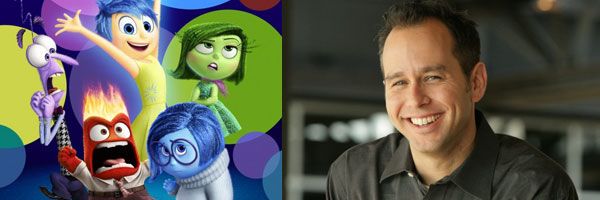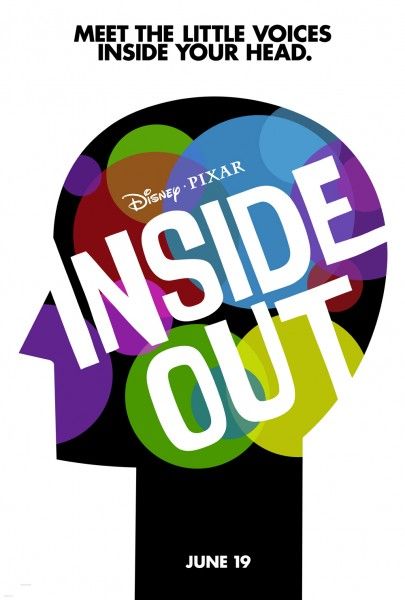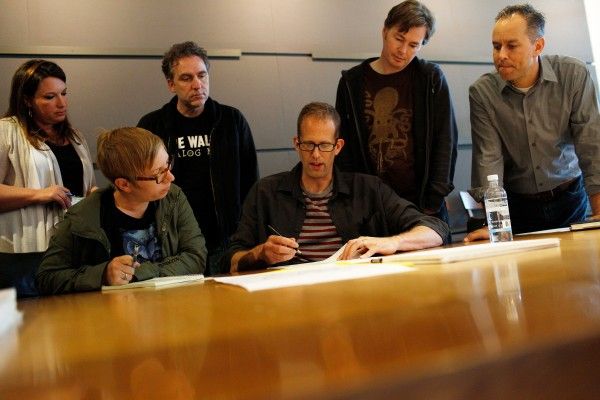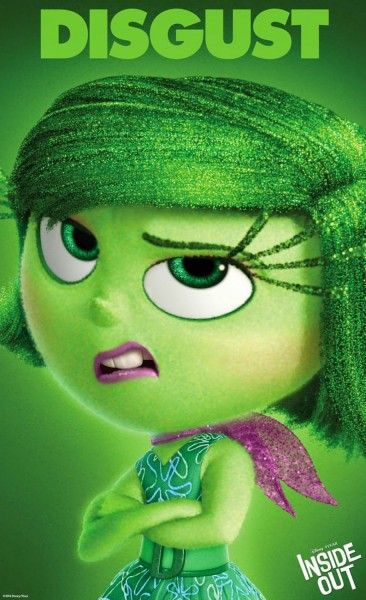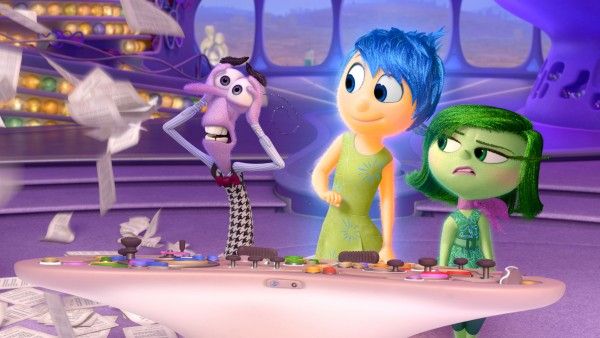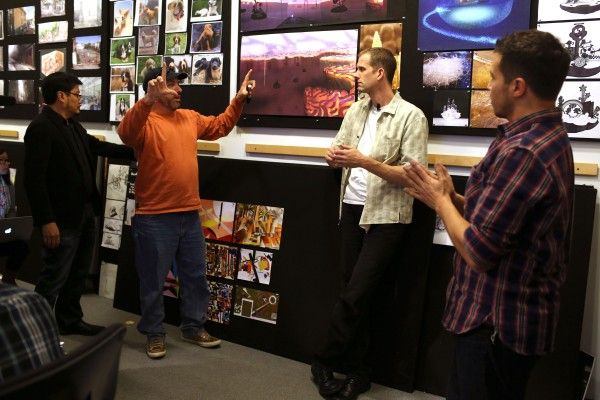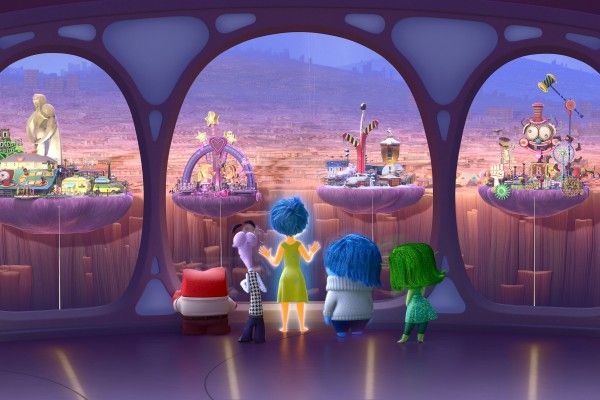Ever since the cruel people at Disney and Pixar screened 56 minutes of footage from Inside Out and then cut it off right before rolling into the third act, the only thing that’s been keeping me from going crazy while waiting to see the rest is preparing the interviews I got to do with a few of the folks behind the film. I posted a roundtable interview with director Pete Docter and producer Jonas Rivera a few weeks back, but now I’ve got an exclusive one-on-one with Rivera to share that’s got loads more information on the challenges of making the film.
Check out what Rivera had to say about Pixar’s producer-director mix-and-match process, what visual elements are priorities when budgeting an animated film, the new name Andrew Stanton gave Bing Bong and more. You can read about all of that and find out where to catch a Good Dinosaur Easter egg in Inside Out in the full interview below. Inside Out hits theaters on June 19th.
Question: To be completely honest, I thought the trailers were great, but they still left me wondering, ‘How is this going to sustain a full feature and how are they gonna get me to believe that these guys are really in her head in a way that makes them feel like a cohesive character?’
RIVERA: Yeah, yeah. Well, good, I hope that worked because those are very good questions and concerns and things we thought about along the way. You know, as we talked a little bit at the table, it was like, ‘Okay, this is a good concept. Are people gonna buy it? Can we make it look visually acceptable somehow?’ I don’t know. I don’t know. We even had ideas where like, ‘Well, maybe Joy comes out.’ Ronnie [Del Carmen] used to draw little things where she was on her shoulder, like literally. We were struggling with how literal to make it, you know?
What was your first impression when you first heard this idea?
RIVERA: I just fell in love with it. As soon as Pete [Docter] said, I think his words were like, ‘What if we took emotions and personified them and then told a story through their perspective?’ ‘Wow, that’s cool,’ and he said, ‘You know, we could take a little girl because I’ve been looking at Ellie [Docter] and thinking about this and instead of her being the main character, she could be the set.’ Then like, boom, boom, boom! He basically threw three strikes and I’m like, ‘Oh my god. That’s enough of a salad there. We can make something out of that, right?’ And I don’t know, I just felt like, I knew that would be hard. This is easy to say, but we look for those things that are like, ‘Oh, what are the big ideas where the audience feels like, ‘Oh my god, why didn’t I think of that?’ Like, toys coming to life or whatever, or monsters in the closet and there’s only so many of those. We’re big Dineylanders and we’re sitting in my office and I have this map from 1959 of Disneyland and I’m like, yeah, there’s only so many big - like there’s Tomorrowland, Fantasyland and Frontierland, and then there’s like, Bear Country and New Orleans Square, they’re not quite as broad and gettable. I’m like, ‘We don’t wanna do Bear Country. We wanna do Fantasyland,’ right?
Based on what I saw last night, I think you’re pretty much there. How do you end up being a producer on this? Is there some sort of producer rotation at Pixar or do you automatically just work with Pete?
RIVERA: Well, that’s a really good question. I think I kind of automatically work with Pete, although there’s no rules really. Pixar I think has seen that we’re a pretty good team and we build decent teams, and we’ve done pretty good work together, so I think it just kind of works. You know, and Lindsey Collins sort of partners with Andrew Stanton, so there’s sort of these natural - Darla [K. Anderson] produces Lee Unkrich, but again, not every time, a couple of times in a row. I mean, that may change. But I think as long as you’re kind of partnering and doing pretty good work, building the appropriate teams, they kind of like it. Little less headache for them maybe.
As a producer on an animated film, you’re basically overseeing every single department, right?
RIVERA: Yeah, I mean, I have a lot of help, obviously. We have a great associate producer, Mark Nielsen, and Dana Murray is our production manager. It’s really the three of us that kind of divide and conquer over the workload of the show, partnering with the studio, and finance and deployment. But yeah, 230 people on the show at its height, 70 animators. It’s a lot of people to check in with constantly.
It blows my mind how many people are working on mere seconds of footage and then it all comes together into one movie.
RIVERA: You know, it blows my mind too, and I think editorial are, in some ways, the unsung heroes of animation. Kevin Nolting, our editor, does an amazing job of helping create that myth of spontaneity, because sometimes we’ll record a scene, like the dinner scene, we recorded Diane Lane probably five months after we recorded the kid, so it’s insane how it works and cuts together, but it somehow does.
Can you tell me a little bit about financing? I’ve heard a lot of people say, ‘We couldn’t do this because it would’ve blown our budget,’ so what’s expensive and what’s inexpensive when you’re making an animated movie?
RIVERA: Well, the biggest thing is labor. It’s just people and hours and time. You look at your movie and you look at the big picture things and you try to save the director and the production from itself a little bit with spending your weeks and time on things that aren’t gonna be worth it. I’ll give you an example, Disgust. We did the design of Disgust, they were drawing her and we’d approved her, we did the sculpt and John [Lasseter] loved her, and she had very long hair and just very beautiful straight hair which we built and we did everything, and when I looked at it I thought, ‘You know, that’s not necessarily a plot point.’ I talked to the supervising technical director and I said, ‘How much is it gonna cost us per shot if she’s in 500 shots?’ ‘Oh, it’s gonna be about a week per shot.’ So if she did anything, did this, or moved, or sat down and the hair would go, that’s a week per shot. So I’m thinking, ‘Okay, we have five people on the hair team …’ You know, you start doing the math and I said, ‘Is that worth it?’ So I literally went to Pete and I’m like, ‘Hey Pete, could her hair be short? If her hair is here and it doesn’t touch her shoulders as much, we could save 100 weeks and if we have 100 weeks we could get another animator …’ You start playing chess with your own pieces, and he goes, ‘Yeah, that’s fair. I kind of like it, but that’s fair.’ So I barter in time versus what’s screen-punch, you know what I mean? Like, what are we gonna spend our money on that [you’re] gonna notice? There’s certain things that I lose. I pushed back on Pete, it’s like, ‘No, that’s important to me. I need to see that reflection in the bottle of water on the table. We need to spend that extra week there.’ So I literally just kind of weigh labor versus time.
So what feature was top priority with budget concerns? Was it the effervescent quality of Joy?
RIVERA: Yeah, the characters and the lighting. Pete has a great metric for it too. We have a good relationship on this. Whenever we’re looking at what could be better in a frame, Pete always draws sort of a bullseye around the eyes of the main character. So here’s Joy and here’s her eyes, that’s where you’re looking, but as we get farther out of that radius, if there’s sort of a problem over here in the window, the further it is from the ground-zero of the character’s eyes, the less susceptible he’ll be to us having to fix it or redo things or spend money on it. So I kind of know what he looks for and so forth.
How about choosing the emotions? You touched on it a little bit during the presentation before you screened the footage last night, but can you go into a little more detail about the other emotions that you were considering?
RIVERA: I think we just landed on the five because we were concerned about just clarity. Like, what’s the most gettable seven dwarfs-ish kind of map over this thing, right? Grumpy and Happy. It just felt like those five were all sort of none debatable. Almost everyone agreed that those were sort of in the gamut, and so it was just about clarity of storytelling. Pete felt like five was an uneven good number that could fill the room and I kind of felt like, ‘Yeah, that seems like it’s not too many to build and design and cast for,’ so it sort of fit within the box and fit creatively, so we just kind of narrowed it down to what the movie needed.
Obviously his name is escaping me now, but I wanted to ask about the imaginary friend.
RIVERA: Oh yeah, Bing Bong.
I don’t know why I can’t remember that. It’s happened quite a few times today.
RIVERA: Andrew Stanton still calls him Billabong and I’m like, ‘Andrew …’
Can you tell me about the decision to incorporate him and also about coming up with the design, too? You basically could have thrown whatever you wanted in there.
RIVERA: There are sort of no rules and so Bing Bong was just this fun idea that if you had in the mind, where you have memories and so forth, reminiscence of where you were as a kid - like I love Imagination Land, where thing are literal from what you imagined as a kid, but it’s also under construction and changing, so what if there’s a person? And we thought, ‘Well, we all had kind of imaginary friends,’ and not everyone might have one, I don’t know if you did, but we all talked about that and so Pete just thought that was the funniest thing like, ‘Let’s make him literally what a kid would say.’ So that idea of a kid drawing on a wall, like this weird elephant, half cat because she says, ‘Yeah, back in the day animal sounds were all the rage. That’s all kids talked about,’ and Joy’s like, ‘Yeah, that’s true.’ So we took those things and candy and whatever, and made a literal person out of it. He’s dressed sort of like a hobo because he’s been out of work for, you know, eight years. She hasn’t really thought of him so poor Bing Bong’s been wandering down in the mind, but he does know a lot. He does know how it works, so he’s also this sort of map so to speak for them.
I’ve had a lot of fun thinking about this since watching the footage; have you ever thought about what your personality islands would be?
RIVERA: Oh, yeah, yeah. Have you?
I’ve been thinking about it non-stop since last night and can’t quite figure out the exact combination.
RVERA: Yeah, I know. I go back to like, ‘Okay, I love movies, I love animation,’ it’s probably like when I first saw Snow White or saw Star Wars or something, and I play guitar so maybe it’s when I did that, watched baseball games, you know, all the things I love. And we think everyone has a family island or a best friend island, I don’t know.
Seems like a must.
RIVERA: A must, right? It seems like it’s a must. It’s just literally the personification of who you are, who this kid is. I don’t know, what’s one of yours?
I’d probably say movies, sports and family. And Pets!
RIVERA: Pets! That’s a good one!
Or does pets count as family?
RIVERA: I guess it could. But that’s a good one. I hadn’t thought of that one. We never did that one.
Now without spoiling anything, can you hint at any Easter eggs people can keep an eye out for? I caught the ball, but that was all I saw.
RIVERA: I’ll give you a good one. In the scene where Mom and Riley are walking down the street and she says, ‘The food was better than the diner in Nebraska. What was your favorite part of the trip?’ And Riley says, ‘I think the dinosaur.’ So they go back, we see the car smash into the dinosaur. She says, ‘Oh, good one Joy!’ That dinosaur may or may not be a cemented version of some of our characters in the next movie we’re doing.

